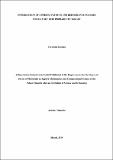| dc.description.abstract | This dissertation is devoted to the mathematical investigation of the topic: Optimization of
Dividend Payouts and Reinsurance Policies under a Set Ruin Probability Target. Its purposes
are, first, to determine the optimal reinsurance and dividend policies for an insurance company
whose surplus is modelled by a diffusion-perturbed classical risk process and, second, to determine
the reinsurance and dividend strategies under a set ruin probability target. The dissertation
concerns itself with three aspects of risk theory: (a) minimization of infinite ruin probability,
which resulted in one published journal paper; (b) maximization of dividend payments, resulting
in a second published paper; and (c) computing optimal dividend barriers based on set
ruin probability targets, whose research paper is still in draft form. All three papers are based
on a diffusion-perturbed classical risk process compounded by quota-share and excess-of-loss
reinsurance. By means of the dynamic programming approach and the application of Itˆo’s
formula, the Hamilton-Jacobi-Bellman (HJB) equations for the optimization problems were
derived. Additionally, the corresponding second-order Volterra integrodifferential equations
(VIDEs) were obtained. These VIDEs were then transformed into Volterra integral equations
(VIEs) of the second kind which were subsequently solved using the fourth-order block-byblock
method based on Simpson’s Rule to determine the optimal value functions. The results
of the problem of minimizing the ruin probability show that the optimal reinsurance policy is
(k ; a ) = (0;1), where k and a are, respectively, the optimal retention levels for quotashare
and excess-of-loss reinsurance. This applies to both the Cram´er-Lundberg (CLM) and
diffusion-perturbed models (DPM). For the dividend maximization problem, results indicate
that for the CLM the optimal reinsurance policy is (k ; a ) = (1;1) for small claims and
(k ; a ) = (1; 10) for large claims. The optimal dividend barrier levels for small and large
claims in the CLM, respectively, are b = 10:27 and b = 9:35. For the DPM, the optimal
reinsurance policy is the same as for the CLM, with optimal dividend barriers b = 12:35 for small claims and b = 11:50 for large claims. This means higher optimal dividend barriers should be used for small claims than for large ones. With regard to ruin probability targets, results show that the optimal dividend barrier increases as the ruin probability reduces. | en_US |

